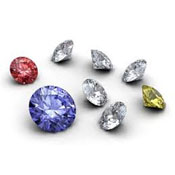Diamond
(dahy-muh nd)
HISTORY and LORE
- Diamond probably made its first appearance in Europe during the Roman Empire, but it was prized in India – the most ancient source of diamonds – long before then.
- The gem’s name comes from Greek adamas meaning unconquerable. For centuries, most people believed diamonds were unbreakable. By association, diamonds came to be credited with the power to bless their owners with strength, courage, success, and enduring love.
- According to some old legends, diamonds are born from heavenly rain or lightning. Other traditions say diamonds are splinters of broken stars. The Romans believed Cupid’s arrows were tipped with diamonds.
- Diamonds have been part of courtship for more than 500 years. In 1477 Archduke Maximilian of Austria gave Mary of Burgundy a diamond ring to symbolize his love and seal their betrothal. Today 8 out of 10 American brides receive a diamond engagement ring.
- Birthstone for April. Gem for the 10th, 60th, and 75th wedding anniversaries.
VALUE FACTORS
- Color: The normal market range is colorless to light yellow, brown, or gray. Deeper yellows, browns, and grays, as well as all shades of other hues, are classified as fancy colors. In the normal range, the closer to colorless the higher the value. With fancy colors, value generally increases with color intensity. Vivid reds, pinks, purples, greens, and blues are extremely rare and expensive.
- Clarity: Standards are stricter than for any other gem. Graded on a detailed scale that runs from flawless under 10x magnification to obviously included to the unaided eye.
- Cut: Faceted in many shapes and styles. The round brilliant cut is the most popular.
- Carat Weight: Available in all jewelry sizes. Average for engagement ring diamonds is about 0.50 carat. The world’s largest fashioned diamond of fine quality is the Great Star of Africa (also called Cullinan I), which weighs 530.20 carats.
TREATMENT
Diamonds many be treated in several ways and should the jeweler you choose should ALWAYS disclose any treatment.
- Laser drilling, followed by chemical bleaching, is a common way to lighten dark inclusions.
- Also fairly common is filling fractures and cleavages with a special property glass substance to improve clarity appearance.
- Irradiation can create fancy color in light yellow or brown diamonds, and deepen or intensify some natural fancy colors. There are several different methods, and they’re often combined with heating. The results include various shades of blue, green, orange, red, pink, yellow, and brown. Many black diamonds are also produced by irradiation.
- High pressure, high temperature (HPHT) treatment removes some or all color from certain types of light brown diamonds. It can color other diamonds pink, blue, yellow, green or orange. HPHT treatment or high temperature alone is also used to color diamonds black.
- Permanence and special care: Most diamond color treatments are normally permanent and create no special care requirements. Ultrasonic, cleaning, steam or heat can harm some fillings.
GEMOLOGY
- Classified as a mineral species. Composed of almost pure carbon. Gem quality diamonds are typically 99.95% carbon and can be more than 99.99% pure. This makes diamond one of the purest materials found in Nature. Diamond is also the only gem composed of just one element.
- The arrangement of carbon atoms in gem quality diamond crystals is almost perfectly symmetrical in every direction. Scientists describe this pattern as isometric or cubic.
- Minute amounts of nitrogen tint diamonds various shades of yellow. Traces of boron produce blue. Distortions in crystal structure are responsible for browns, pinks, reds and purples. Some other colors come from a combination of trace elements and structural irregularities.
CARE
Diamond generally has good to excellent wearability.
- Hardness: Exceptional scratch resistance. Rates 10 on the Mohs Hardness Scale. Diamond is the hardest material known.
- Toughness: Resistance to chipping and breaking is normally good. Clarity characteristics may affect durability, and diamond possesses cleavage (a tendency to break in certain directions due to crystal structure patterns).
- Stability: No routine concerns for gem owners.
- Cleaning: Liquid cleaner or detergent and water. Ultrasonic is also safe except for fracture-filled diamonds.
